"Soup at
TsUP"
A pilgrimage to the roots of
spaceflight
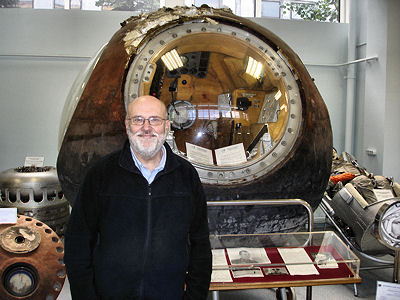 The last week of May 2008 I
had the opportunity to fulfill a dream of every spaceflight enthusiast – that of
visiting the “roots of spaceflight” in Russia, i.e. the factory where the first
Sputnik, the first moon probe and the first manned spacecraft were built under
the leadership of the famous chief designer Sergei Korolev, the cosmonaut
training center and the mission control center for manned Russian spacecraft
(TsUP = Tsentr Upravleniya Poloyotami, pronounced “tsoop”, i.e. Flight Control
Center).
The last week of May 2008 I
had the opportunity to fulfill a dream of every spaceflight enthusiast – that of
visiting the “roots of spaceflight” in Russia, i.e. the factory where the first
Sputnik, the first moon probe and the first manned spacecraft were built under
the leadership of the famous chief designer Sergei Korolev, the cosmonaut
training center and the mission control center for manned Russian spacecraft
(TsUP = Tsentr Upravleniya Poloyotami, pronounced “tsoop”, i.e. Flight Control
Center).
I and another space enthusiast, Bob Christy of
Lincoln, U.K., traveled to Moscow at the invitation of Vladimir Agapov, a space
debris specialist at the Keldysh Institute of Applied Mathematics of the Russian
Academy of Sciences. His friends at Russian space journal Novosti Kosmonavtiki
also took care of us!
The organization that Sergei Korolev led is
nowadays called Rocket-Spacecraft Corporation Energia but still located in
the vast industrial complex in a northern suburb of Moscow bearing the chief
designer’s name. The only part of Energia open to the “space technology tourist”
is its museum where there are exact replicas of the classical unmanned spacecraft such as the
first three Sputniks and the first probes to reach the Moon as well as the actual
capsules that carried Yuri Gagarin and Valentina Tereshkova into space. It was
hard not to feel solemn when I stood in front of the Vostok-1 capsule which
carried the first human into space 47 years in the past. It is a museum
piece that one can approach up close. This museum is remarkable in its
accessibility. One can touch and feel most exhibits and examine technical
details at almost microscope distance.
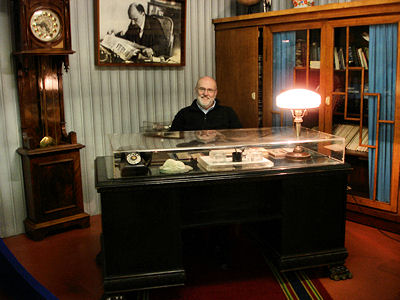 Before entering the
old factory hall converted into a museum the visitor passes through what could
almost be called a shrine dedicated to Sergei Korolev who died in 1966 at the
age of 59 after having led his great design bureau for only 20 years and created
the first intercontinental missile and then the famous spacecraft that started
the space age. Since we were only a group of two persons it was possible for us
to sit behind Korolev’s desk in his office chair. The reconstructed office even
contains a photo of Lenin reading Pravda on the wall.
Before entering the
old factory hall converted into a museum the visitor passes through what could
almost be called a shrine dedicated to Sergei Korolev who died in 1966 at the
age of 59 after having led his great design bureau for only 20 years and created
the first intercontinental missile and then the famous spacecraft that started
the space age. Since we were only a group of two persons it was possible for us
to sit behind Korolev’s desk in his office chair. The reconstructed office even
contains a photo of Lenin reading Pravda on the wall.
The following day
we returned to the suburb Korolev to visit the mission control center TsUP
located in a part of TsNIIMash, the Central
Scientific Research Institute for Machine Building (The Institute plays a
central role in spacecraft and rocket technology and reports to Russian Space
Agency. The Institute is responsible for system analyses, research and
development of spacecraft and rocket programs, as well as for the Russian space
program as a whole).
There are two major control rooms at TsUP –
one built for the Soviet-US docking in space in 1975 (Apollo-Soyuz Test Project,
ASTP) and the other built for the Soviet space shuttle Buran. The ASTP
control room is used as mission control for civilian space missions and launches
of the US/Russian/Norwegian Sea Launch rocket.
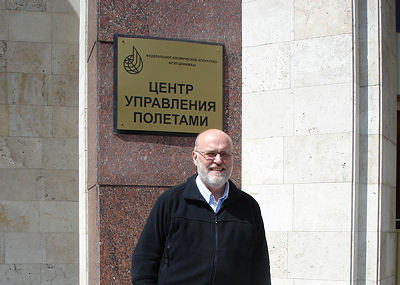 When we entered
the ASTP control room the displays showed that the center supported the
Resurs-DK1 earth observation satellite that also carries a cosmic particle
instrument – PAMELA – with Swedish participation. There were no staff in the main control room, but we were
assured that there were people in the “back rooms”. By contrast the ISS control
room in the control center built for Buran was staffed. A handful of persons sat
at the consoles.
When we entered
the ASTP control room the displays showed that the center supported the
Resurs-DK1 earth observation satellite that also carries a cosmic particle
instrument – PAMELA – with Swedish participation. There were no staff in the main control room, but we were
assured that there were people in the “back rooms”. By contrast the ISS control
room in the control center built for Buran was staffed. A handful of persons sat
at the consoles.
The space station was not passing anywhere near
Russia at the time. A rehearsal of some sort in preparation for the launch of
the Space Shuttle STS-124) four days later was going on. At the visitors’
balcony there were a couple of telephones with the pictures of the current crew
attached to them. These telephones are used by VIP visitors to talk to the crew.
Before we left TsUp we were served lunch at one of the small buffets in
the center. We all chose borscht – Russian soup – of course. "Soup at TsUP" - I
can't resist the pun!
After the visit to TsUP we continued in an easterly
direction to the Yuri Gagarin Cosmonaut Training Center
(TsPK) 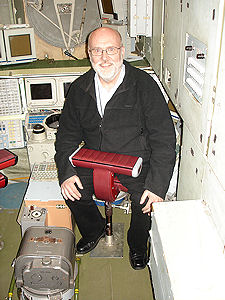 where we met a very engaging
tour guide Boris Yesin, who has retired from a technical position at the center.
He took us to the Mir simulator which is a high-fidelity simulator and not just
an exhibition piece. When powered up, every button pushed produced a reaction.
The simulator is complete with a “treadmill” for keeping fit and a fully
assembled toilet. Interestingly, the seats in front of the main control console
seem like they are assembled backwards (see image on the right) but in reality
this feature keeps the cosmonaut attached to the seat instead of floating away
in microgravity.
where we met a very engaging
tour guide Boris Yesin, who has retired from a technical position at the center.
He took us to the Mir simulator which is a high-fidelity simulator and not just
an exhibition piece. When powered up, every button pushed produced a reaction.
The simulator is complete with a “treadmill” for keeping fit and a fully
assembled toilet. Interestingly, the seats in front of the main control console
seem like they are assembled backwards (see image on the right) but in reality
this feature keeps the cosmonaut attached to the seat instead of floating away
in microgravity.
Another high point at TsPK is the gigantic centrifuge
used to train crew members to withstand the rigors of accelerations during
launch and landing. This centrifuge was built by the Swedish company ASEA
(nowadays ABB) and delivered to TsPK from Västerås near Stockholm and taken over
by the customer in 1980 – nine years after the contract was signed (negotiations
had started already in 1968!). The centrifuge uses what is probably the world’s
largest DC electric motor that has a rotor with 4.5 meter diameter and consumes
27000 amperes when accelerating at the maximum rate.
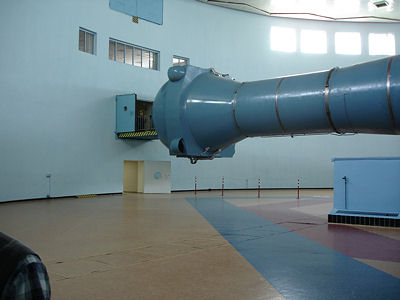 The
rotation radius is an impressive 18 m and the maximum g-level in the crew cabin
is 30 g. The centrifuge is capable of increasing the g-level at a rate of 5 g/s.
There are two interchangeable crew cabins for one and two pilots,
respectively. The pressure in the cabins can be varied in the range 40-800
mm Hg while the temperature can be controlled between +5 °C and +50 °C. When the
centrifuge spins at maximum speed the velocity of the crew cabin is 250
km/h!
The
rotation radius is an impressive 18 m and the maximum g-level in the crew cabin
is 30 g. The centrifuge is capable of increasing the g-level at a rate of 5 g/s.
There are two interchangeable crew cabins for one and two pilots,
respectively. The pressure in the cabins can be varied in the range 40-800
mm Hg while the temperature can be controlled between +5 °C and +50 °C. When the
centrifuge spins at maximum speed the velocity of the crew cabin is 250
km/h!
It felt good to see this massive piece of machinery – a
product of Swedish engineering prowess!
The visit to the Moscow region
contained two more visits to space history shrines. We visited the museum
dedicated to the president of the Academy of Sciences during the halcyon days of
space exploration, Mstislav Keldysh. His office has been preserved as it was in
the mid 70’s when he passed away. It was Keldysh and Korolev that drove early
space exploration projects. We were shown the original, declassified, documents
from the late 40’s examining the feasibility of artificial satellites and long
range missiles.
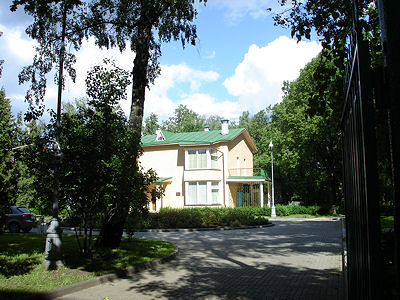 Bob and I strolled in the
neighbourhood of the Cosmos hotel near VDNKh, the old All-Union Exhibition
Centre and the Monument to the Conquerors of Space, Cosmonaut Alley and the
new space museum then under refurbishment. On 28, Ostnakinoskaya Ulitsa we
found the home of Sergei Korolev, now a museum. Korolev lived there from 1959
until 1966. We had missed the last guided tour by 15 minutes. But we
were lucky that a car passed out through the gate so that we could take good
pictures of the house.
Bob and I strolled in the
neighbourhood of the Cosmos hotel near VDNKh, the old All-Union Exhibition
Centre and the Monument to the Conquerors of Space, Cosmonaut Alley and the
new space museum then under refurbishment. On 28, Ostnakinoskaya Ulitsa we
found the home of Sergei Korolev, now a museum. Korolev lived there from 1959
until 1966. We had missed the last guided tour by 15 minutes. But we
were lucky that a car passed out through the gate so that we could take good
pictures of the house.
It was established as a museum
in1975. The house is located 1.3 km from the Ostankino TV tower, located near the Ostankino TV-center
where dramatic events occurred during the Russian constitutional crisis on
3 October 1993.
We also traveled 200 km southwest
to the town Kaluga where Konstantin Eduardovich Tsiolkovsky (1857-1935), teacher, scientist and pioneer of
astronautics theory lived and worked. There is a space museum and park to his honor
and his home and small laboratory in a typical Russian paneled log house
is preserved.
With that visit our pilgrimage to the “roots of
spaceflight” ended.
"Earth is the cradle of the mind, but you can not live forever in a cradle"
– Konstantin
Tsiolkovsky

 Back to Space History Notes
Back to Space History Notes
 The last week of May 2008 I
had the opportunity to fulfill a dream of every spaceflight enthusiast – that of
visiting the “roots of spaceflight” in Russia, i.e. the factory where the first
Sputnik, the first moon probe and the first manned spacecraft were built under
the leadership of the famous chief designer Sergei Korolev, the cosmonaut
training center and the mission control center for manned Russian spacecraft
(TsUP = Tsentr Upravleniya Poloyotami, pronounced “tsoop”, i.e. Flight Control
Center).
The last week of May 2008 I
had the opportunity to fulfill a dream of every spaceflight enthusiast – that of
visiting the “roots of spaceflight” in Russia, i.e. the factory where the first
Sputnik, the first moon probe and the first manned spacecraft were built under
the leadership of the famous chief designer Sergei Korolev, the cosmonaut
training center and the mission control center for manned Russian spacecraft
(TsUP = Tsentr Upravleniya Poloyotami, pronounced “tsoop”, i.e. Flight Control
Center).  Before entering the
old factory hall converted into a museum the visitor passes through what could
almost be called a shrine dedicated to Sergei Korolev who died in 1966 at the
age of 59 after having led his great design bureau for only 20 years and created
the first intercontinental missile and then the famous spacecraft that started
the space age. Since we were only a group of two persons it was possible for us
to sit behind Korolev’s desk in his office chair. The reconstructed office even
contains a photo of Lenin reading Pravda on the wall.
Before entering the
old factory hall converted into a museum the visitor passes through what could
almost be called a shrine dedicated to Sergei Korolev who died in 1966 at the
age of 59 after having led his great design bureau for only 20 years and created
the first intercontinental missile and then the famous spacecraft that started
the space age. Since we were only a group of two persons it was possible for us
to sit behind Korolev’s desk in his office chair. The reconstructed office even
contains a photo of Lenin reading Pravda on the wall.  When we entered
the ASTP control room the displays showed that the center supported the
Resurs-DK1 earth observation satellite that also carries a cosmic particle
instrument –
When we entered
the ASTP control room the displays showed that the center supported the
Resurs-DK1 earth observation satellite that also carries a cosmic particle
instrument –  where we met a very engaging
tour guide Boris Yesin, who has retired from a technical position at the center.
He took us to the Mir simulator which is a high-fidelity simulator and not just
an exhibition piece. When powered up, every button pushed produced a reaction.
The simulator is complete with a “treadmill” for keeping fit and a fully
assembled toilet. Interestingly, the seats in front of the main control console
seem like they are assembled backwards (see image on the right) but in reality
this feature keeps the cosmonaut attached to the seat instead of floating away
in microgravity.
where we met a very engaging
tour guide Boris Yesin, who has retired from a technical position at the center.
He took us to the Mir simulator which is a high-fidelity simulator and not just
an exhibition piece. When powered up, every button pushed produced a reaction.
The simulator is complete with a “treadmill” for keeping fit and a fully
assembled toilet. Interestingly, the seats in front of the main control console
seem like they are assembled backwards (see image on the right) but in reality
this feature keeps the cosmonaut attached to the seat instead of floating away
in microgravity. The
rotation radius is an impressive 18 m and the maximum g-level in the crew cabin
is 30 g. The centrifuge is capable of increasing the g-level at a rate of 5 g/s.
There are two interchangeable crew cabins for one and two pilots,
respectively. The pressure in the cabins can be varied in the range 40-800
mm Hg while the temperature can be controlled between +5 °C and +50 °C. When the
centrifuge spins at maximum speed the velocity of the crew cabin is 250
km/h!
The
rotation radius is an impressive 18 m and the maximum g-level in the crew cabin
is 30 g. The centrifuge is capable of increasing the g-level at a rate of 5 g/s.
There are two interchangeable crew cabins for one and two pilots,
respectively. The pressure in the cabins can be varied in the range 40-800
mm Hg while the temperature can be controlled between +5 °C and +50 °C. When the
centrifuge spins at maximum speed the velocity of the crew cabin is 250
km/h!  Bob and I strolled in the
neighbourhood of the Cosmos hotel near VDNKh, the old All-Union Exhibition
Centre and the Monument to the Conquerors of Space, Cosmonaut Alley and the
new space museum then under refurbishment. On 28, Ostnakinoskaya Ulitsa we
found the home of Sergei Korolev, now a museum. Korolev lived there from 1959
until 1966. We had missed the last guided tour by 15 minutes. But we
were lucky that a car passed out through the gate so that we could take good
pictures of the house.
Bob and I strolled in the
neighbourhood of the Cosmos hotel near VDNKh, the old All-Union Exhibition
Centre and the Monument to the Conquerors of Space, Cosmonaut Alley and the
new space museum then under refurbishment. On 28, Ostnakinoskaya Ulitsa we
found the home of Sergei Korolev, now a museum. Korolev lived there from 1959
until 1966. We had missed the last guided tour by 15 minutes. But we
were lucky that a car passed out through the gate so that we could take good
pictures of the house.